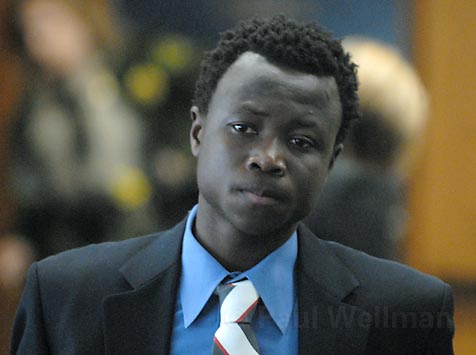Former Soccer Star Faces Eight Years Behind Bars
Frimpong Guilty

Ajury of nine women and three men took less than a day of deliberation to find former UCSB soccer player Eric Frimpong guilty of rape, leaving a 19-year-old victim relieved the trial is over and a group of Frimpong’s supporters wondering what went wrong.
The jury gathered in the jury room briefly on Friday, December 14, before Superior Court Judge Brian Hill sent them home early for the weekend. By 3:30 p.m. Monday, a verdict had been reached. Despite the amount of evidence presented, prosecutor Mary Barron wasn’t surprised by the length of time the jury took to come to a conclusion. “I thought the evidence was very strong in this case,” said Barron, who on Friday called the evidence “unrelenting.” The judge took a poll of the jury after the verdict was read, asking each individual if they agreed with the finding. All of the jurors, some of them crying and emotional, said yes. “It was hard because none of us wanted it to be that way,” one juror said later. The victim wasn’t in the courtroom Monday for the verdict, but the small contingent of people who have been by Frimpong’s side were, including Paul Monahan, who has paid for much of Frimpong’s legal defense. Monahan’s son, Patrick, was a roommate with Frimpong at UCSB. When the verdict was read, Paul Monahan’s wife burst out, “It’s not right.” And then Frimpong was led off in handcuffs to begin his sentence, the length of which will be determined January 31 when Hill will decide if the Ghana native will serve three, six, or the maximum eight years behind bars. The defense will be appealing the outcome, although on what grounds isn’t clear. Defense attorney Bob Sanger filed multiple motions for mistrials throughout the case, based on apparent prosecutor missteps along the way. A motion for a retrial has already been filed, according to Monahan and Tim Vom Steeg, UCSB’s soccer coach. Sanger didn’t return multiple calls to his office before deadline.
In his closing arguments, Sanger explained why he called only one witness and why he didn’t have Frimpong testify. “The evidence is so faulty and such a mess, we’re stopping,” he said, adding that stacking remote possibility on top of remote possibility doesn’t prove anything beyond a reasonable doubt, as the court requires. But the jury disagreed, finding a “pattern” to the evidence presented, said jury foreperson Jim Dougherty. “When you take the testimony and information and when you put it together, it was very consistent,” Dougherty said.
Sanger also questioned the ability of the victim to even remember what happened in the early morning of February 17, the night on which she was raped on an Isla Vista beach. While she couldn’t remember some parts of the night as a result of intoxication, her descriptions of what happened resonated with the jury. “[Sanger] wanted us to believe that for a short period of time she blacked out,” said juror Annmarie Cameron, adding that no evidence supported that. “She had amazing clarity in her interviews,” Cameron said. Barron said she spoke with the victim after the verdict, and the young woman said she was appreciative of the work of law enforcement. “She’s very relieved it’s behind her now,” Barron said.
Frimpong supporters questioned the honesty of lead investigator Detective Daniel Kies’s testimony on the stand and his handling of evidence, but the jury didn’t see any evidence of major wrongdoing or dishonesty from the detective. Vom Steeg-who described Frimpong as “humble, very modest, very unassuming”-expressed shock at the conviction in light of how none of Frimpong’s DNA was found on the victim. “When somebody rapes somebody, they leave something behind,” he said. But Barron, pointing out that rapes occurred before the technology and science to find and decipher DNA was available, said convictions are still made based on other evidence. “It’s important to remember that just because DNA is not detected doesn’t mean it’s not there,” Barron said. “[The results] are easily explained by biology and the mechanics of how DNA is transferred.”
The fact that none of Frimpong’s DNA was found anywhere on the victim, but that the victim’s DNA was found on Frimpong’s genitals, was just one of the perplexing aspects of the case. Some jurors had trouble with certain evidence, Dougherty explained, but all the pieces of the puzzle started to come together when the evidence was considered as a whole, he said.
With the end of the trial comes the realization by many that the lives of the victim and Frimpong, as well as their friends and families, and the jurors who heard the case, have been forever altered by the events of the past year. “Somehow the world looks different today,” Vom Steeg said.



